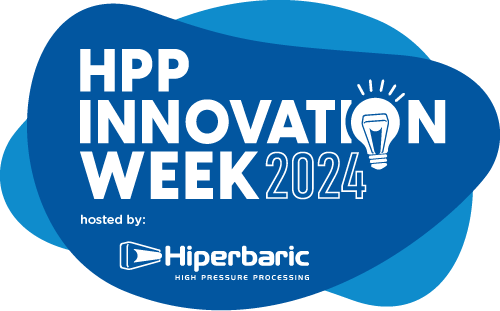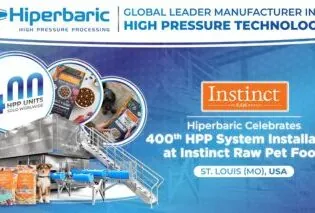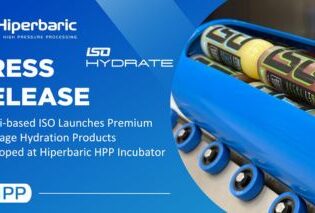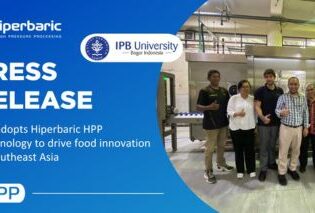

The deli or cooked meat sector is suffering some constraints such as limited shelf-life, Listeria control, and consumer demand for clean label products. High Pressure Processing (HPP) is revolutionizing this sector by significantly extending shelf-life and effectively reducing Listeria levels, ensuring enhanced safety. Additionally, HPP complements clean label initiatives by enabling salt reduction studies. These advancements in quality and safety demonstrate HPP’s pivotal role in meeting consumer preferences while elevating industry standards. By integrating HPP, the deli meat sector not only ensures product excellence but also embraces innovation and sustainability, catering to the ever-changing demands of a discerning consumer base.
In the realm of processed meat, the category of deli meat products encompasses a wide range of delectable offerings such as sausages, whole, formed, or sliced ham, whole and split roast beef, chicken breast fillets and strips, and more. These products undergo specific cooking processes to enhance flavor and tenderness, making them popular choices for consumers seeking convenience without compromising on taste.
After the production of Ready-to-Eat (RTE) meat products, various processing steps such as cutting, slicing, and packaging can lead to microbial recontamination in the final commercial products. All this added to the fact that RTE meat products are consumed without any additional preparation or cooking, which increases the microbiological risk associated with these products. And this risk grows over their shelf-life as pathogens can develop. To mitigate this risk, additives are used, or the products are marketed with shorter shelf-lives. However, this is not ideal as it leads to more waste, complicates inventory control, and fails to meet the demands required by supermarkets.
Therefore, the sector faces various constraints that pose challenges to manufacturers and impact product quality and safety. These constraints include limited shelf-life, the need for L. monocytogenes control, and the growing demand for clean label products.
Overcoming Constraints with HPP
High Pressure Processing (HPP) emerges as a disruptive technology that can effectively overcome these limitations and elevate the quality and safety of deli meat products. HPP is a nonthermal food preservation method that uses extremely high pressure, typically up to 600 MPa (87,000 psi), to inactivate pathogens and spoilage microorganisms in food products. The utilization of HPP by the meat industry is a long-standing practice. Primarily, HPP has been applied within the RTE meat products industry, as a novel post-packaging, nonthermal decontamination approach. It is a straightforward, yet effective means of reducing microbial levels, thereby extending the shelf-life and improving the safety of the product.
Shelf-life Enhancement
HPP is renowned for extending the shelf-life of food products through the application of high levels of pressure, which helps in eliminating microorganisms (such as lactic acid bacteria, Pseudomonas spp., yeasts, etc.) and enzymes that contribute to spoilage. Studies have shown significant improvements in shelf-life extension between unprocessed cooked meats and those treated with HPP at 600 MPa (87,000 psi) between 2 and 5 min of pressure holding time for various cooked meat products, such as sausages, ‘lacón’ and chicken breast (Figure 1).
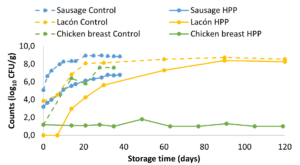
The results clearly demonstrate the superior preservation capabilities of HPP in extending the shelf-life of diverse deli meat products during long storage periods. As can be seen in the graph above, sausages doubled their shelf-life, and the shelf-life of the rest increased from 14 days to 30 days for “lacón” and 120 days for chicken breast (Dang et al., 2021; Del Olmo et al., 2014 and Katsaros & Taoukis, 2021).
Listeria Control
Listeria monocytogenes poses a significant risk in the food industry, particularly in RTE meats where contamination can lead to severe health implications in at-risk populations. HPP serves as an effective method for controlling and reducing the presence of the pathogen in cooked meat products. Consequently, this can reduce the need for chemical preservatives to prevent its growth, as discussed further.
The FSIS and Health Canada have recognized HPP as an effective post-lethality treatment (PLT) to eliminate the post-processing contamination by L. monocytogenes. Through extensive scientific research, it has been determined that the application of 600 MPa (87,000 psi) for 3 min is sufficient to achieve at least a 3 log10 reduction in L. monocytogenes present in RTE meat products (Health Canada, 2020).
Numerous scientific investigations have established that HPP is capable of deactivating L. monocytogenes on RTE meat products. For instance, the effect of pressure intensity and time on the inactivation of L. monocytogenes in RTE sliced ham was evaluated (Figure 2). The results revealed that L. monocytogenes inactivation is more pronounced at higher pressure levels (>550 MPa / >79,800 psi). After a pressure holding time of 3 min, a maximum reduction of 5.4 log10 units at 550 MPa (79,800 psi), and 6.7 log10 units at 600 MPa (87,000 psi) was observed. Increasing pressure holding time beyond 3 min at these two pressure levels showed no further increase in inactivation (Hereu et al., 2012).
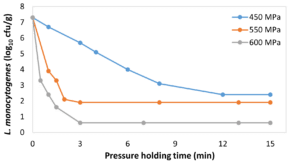
Clean Label Initiatives
In response to the growing consumer demand for clean label products, manufacturers are exploring innovative approaches to reduce the use of artificial additives in cooked meat formulations. Since deli meats are subjected to HPP in their final commercial package, the products avoid environmental contamination after treatment. Consequently, the preservatives that are conventionally added to mitigate such contamination can be eliminated or significantly reduced.
Additionally, studies on NaCl reduction in cooked meat products have shown promising results when combined with HPP, demonstrating the feasibility of developing clean label alternatives without compromising taste or safety.
High pressure promotes tighter binding of sodium to proteins, and at the same time, protein denaturation, which would explain the increase in saltiness perception (Picouet et al., 2012). The phenomena would allow the manufacturing of low-sodium meat products by using HPP technology, such as naturally-cured sausages or restructured hams (Pietrasik et al., 2016, 2017; Stollewerk et al., 2012).
By leveraging the capabilities of HPP technology, the cooked meat sector can overcome these constraints, enhance product quality and safety, and meet the evolving preferences of consumers for clean, healthy, and flavorful food options. Embracing HPP as a key solution in the production of cooked meat products not only elevates industry standards but also ensures consumer trust and satisfaction in every bite they enjoy.
Do not hesitate to contact us if you would like to know more about this technology.

